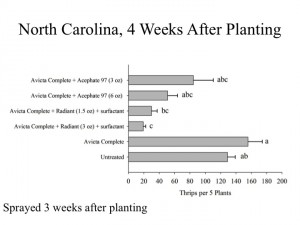Getting Ready to Drill Down on Thrips
go.ncsu.edu/readext?299986
en Español / em Português
El inglés es el idioma de control de esta página. En la medida en que haya algún conflicto entre la traducción al inglés y la traducción, el inglés prevalece.
Al hacer clic en el enlace de traducción se activa un servicio de traducción gratuito para convertir la página al español. Al igual que con cualquier traducción por Internet, la conversión no es sensible al contexto y puede que no traduzca el texto en su significado original. NC State Extension no garantiza la exactitud del texto traducido. Por favor, tenga en cuenta que algunas aplicaciones y/o servicios pueden no funcionar como se espera cuando se traducen.
Português
Inglês é o idioma de controle desta página. Na medida que haja algum conflito entre o texto original em Inglês e a tradução, o Inglês prevalece.
Ao clicar no link de tradução, um serviço gratuito de tradução será ativado para converter a página para o Português. Como em qualquer tradução pela internet, a conversão não é sensivel ao contexto e pode não ocorrer a tradução para o significado orginal. O serviço de Extensão da Carolina do Norte (NC State Extension) não garante a exatidão do texto traduzido. Por favor, observe que algumas funções ou serviços podem não funcionar como esperado após a tradução.
English
English is the controlling language of this page. To the extent there is any conflict between the English text and the translation, English controls.
Clicking on the translation link activates a free translation service to convert the page to Spanish. As with any Internet translation, the conversion is not context-sensitive and may not translate the text to its original meaning. NC State Extension does not guarantee the accuracy of the translated text. Please note that some applications and/or services may not function as expected when translated.
Collapse ▲I had a chance to scout some more cotton this week and it looks like numbers are picking up a bit, but are still underwhelming compared to this time in previous years. We can expect more thrips to invade our cotton and develop as time goes on. With most of the cotton in the ground and up, we need to focus on managing thrips with foliar sprays.
One grower field that I visited today was planted 2-3 weeks ago and was starting to show some injury on the first true emerging leaf. This is not surprising since the best we can expect from a seed treatment is 3 weeks of protection. With heavy rainfall, we can expect some of the chemical to wash away from the seed without being taken up from the plant. Note that many years of replicated trials in North Carolina have not shown a consistent advantage to one seed treatment over another. However averages can be deceiving, especially in a non-average year. Your choice of seed treatment could be important here, since thiamethoxam is eight times more soluble in water than imidacloprid. Most entomologists across the Southeast agree that a spray timed at the first true leaf (1/4 inch long- photo in this article) is more effective than later sprays. The field I visited today could probably benefit from a foliar overspray.
It is tempting to tank mix sprays for thrips with a trip for herbicides. This can work if your timing is right for thrips and if your mix is compatible (see this tank mix article). If you have palmer problems, you probably have a really good pre-emergent down and you might be a little late for good thrips management. Consider an earlier trip across the field for thrips if it looks like you’re at threshold (two larval thrips per seedling).
Radiant is another option for thrips. Some dealers might not carry this in stock, but there are no supply issues and they can easily order it in a couple days. Also note that you must add surfactant with this chemical to boost the efficacy. One advantage Radiant can provide is that it does not have tank mix/burn problems that you can sometimes run into with acephate. The major advantage for Radiant from my point of view is its efficacy on Western flower thrips. Westerns are difficult to manage with acephate and are generally a spotty problem, but in some years can be bad (especially dry conditions). Be wary of folks who might claim to identify Westerns in the field. While it is generally true that Western adults are light colored, and tobacco thrips are dark colored, the only way to get a positive species identification is by slide mounting and closely looking at characters such as the length of hairs behind the eye. Consider sending in a sample to the NCSU Plant Disease and Insect Clinic for identification if you have problems behind acephate to know what you’re dealing with.



